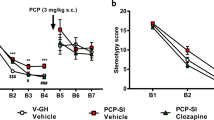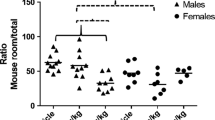Abstract
The aim of the present study was to (i) characterise the mouse behavioural profile (particularly social interactions) during the preweaning period, (ii) assess the effects of prenatal exposure to an anticonvulsant drug widely used in clinical practice, (iii) examine possible genetic differences both in baseline behavioural profiles and in sensitivity to drug-induced effects. Following a balanced intra-strain fostering procedure, the offspring of C57BL/6J and CBA inbred mouse strains from mothers exposed during pregnancy to either phenobarbitone (PHB, 60 mg/kg) or vehicle (VEH) given intraperitoneally (IP) during days 10–16 of gestation, were observed for early social interactions in the home cage during the last part of the preweaning period (days 20 and 21). The behavioural repertoires of the two strains differed markedly, in that C57 pups were more involved in Play soliciting, Locomotor-rotational play, and in Maintenance activities, while CBA mice spent much more time being inactive or exploring the environment. C57 and CBA mice also differed in the sensitivity to PHB exposure. On the whole, time spent in Investigative/Affiliative behaviours was increased, while the frequency of Play soliciting patterns was reduced in PHB-treated mice. The treatment of the fostering mother had only negligible effects, suggesting that PHB-induced changes in behaviour were largely due to direct effects of the substance on the foetus. These results indicate that specific items of the preweaning behavioural profile, and particularly social interactions, are influenced by early PHB exposure, and that the responses are heavily affected by the genotype.
Similar content being viewed by others
References
Alleva E, Bignami G (1985) Development of mouse activity, stimulus reactivity, habituation, and response to amphetamine and scopolamine. Physiol Behav 34:519–523
Altman J (1974) Observational study of behaviour: sampling methods. Behaviour 49:227–265
Bignami G, Alleva E, Chiarotti F, Laviola G (1992) Selective changes in mouse behavioural development after prenatal benzodiazepine exposure: a progress report. Prog Neuropsychopharmacol Biol Psychiatry 16:587–604
Bond NW (1988) Ontogeny of activity in inbred and random-bred strains of mice: effects of scopolamine. Behav Neurosci 102:887–893
Chamove AS (1989) Cage design reduces emotinality in mice. Lab Anim 23:215–219
Chapman JB, Cutler MG (1983a) Behavioural effects of phenobarbitone I.: Effects in the offspring of laboratory mice. Psychopharmacology 79:155–160
Chapman JB, Cutler MG (1983b) Behavioural effects of phenobarbitone II.: Effects in nursing female mice. Psychopharmacology 81:252–257
Chiarotti F, Alleva E, Bignami G (1987) Problems of test choice and data analysis in behavioural teratology: the case of prenatal benzodiazepines. Neurotoxicol Teratol 9:179–186
Clayton RM (1980) An in vitro system for teratogenicity testing. In: Rowan A, Stratman C (eds) Alternatives in drug research. MacMillan, New York, pp 153–173
Crabbe JC (1986) Genetic differences in locomotor activation in mice. Pharmacol Biochem Behav 25:289–292
Deag JM (1983) Keytime. A program system for the analysis of keypress-time data files. Dept of Zoology, University of Edinburgh
Dixon AK, Fisch HU, McAllister KH (1990) Ethopharmacology: a biological approach to the study of drug-induced changes in behaviour. Adv Stud Behav 19:171–210
Donald JM, Cutler MG, Moore MR, Bradley M (1986) Effects of lead in the laboratory mouse-2: development and social behaviour after lifelong administration of a small dose of lead acetate in drinking fluid. Neuropharmacology 25:151–160
Eriksson K, Kiianmaa K (1971) Genetic analysis of susceptibility to morphine addiction in inbred mice. Ann Med Exp Biol Fenn 49:73–78
File SE (1985) Animal models for predicting clinical efficacy of anxiolytic drugs: social behaviour. Neuropsychobiology 13:55–62
Finnel RH, Shields HE, Taylor SM, Chernoff GF (1987) Strain differences in phenobarbital-induced teratogenesis in mice. Teratology 35:177–185.
Fishman RHB, Gaathon A, Yanai J (1982) Early barbiturate treatment eliminates peak serum thyroxine levels in neonatal mice and produces ultrastructural damage in the brains of adults. Dev Brain Res 5:202–205
Forfar JO, Nelson MM (1973) Epidemiology of drugs taken by pregnant women: drugs that may affect the fetus adversely. Clin Pharmacol Ther 14:632–642
Fox WM (1965) Reflex-ontogeny and behavioural development of the mouse. Anim Behav 13:234–241
Grant EC, Macintosh JH (1963) A comparison of the social postures of some common laboratory rodents. Behaviour 21:246–258
Hole GJ, Einon DF (1984) Play in rodents. In: Smith PK (ed) Play in animals and humans. Blackwell, Oxford, pp 95–118
Iadarola MJ, Fanelli RJ, McNamara JO, Wilson WA (1985) Comparison of the effects of diphenylbarbituric acid, phenobarbital, pentobarbital and secobarbital on GABA-mediated inhibition and benzodiazepine binding. J Pharmacol Exp Ther 232:127–133
Ingram DK, Corfman TP (1980) An overview of neurobiological comparisons in mouse strains. Neurosci Biobehav Rev 4:421–435
Insel TR, Hill J, Major RB (1986) Rat pup ultrasonic calls: possible mediation by the benzodiazepine receptor complex. Pharmacol Biochem Behav 24:1263–1267
Izquierdo I, Cunha C, Medina IH (1990) Endogenous benzodiazepine modulation of memory processes. Neurosci Biobehav Rev 14:414–419
Janz D, Schmidt D (1974) Antiepileptic drugs and failure of oral contraceptives. Lancet 1:1113
Laviola G, Alleva E (1990) Play behaviour in laboratory mice: influence of litter composition. Abstract Book of the 23rd Annual Meeting of the International Society for Developmental Psychobiology (July 2–6, 1990, Cambridge, UK)
Laviola G, Loggi G (1992) Sexual segregation in infancy and bi-directional benzodiazepine effects on hot-plate response and neophobia in adult mice. Pharmacol Biochem Behav 42:865–870
Laviola G, Sedowofia K, Innes J, Clayton R, Manning A (1990) Genetic differences in maternal behaviour patterns in mice administered phenobarbital during pregnancy. Psychopharmacology 102:383–390
Laviola G, De Acetis L, Bignami G, Alleva E (1991) Prenatal oxazepam enhances mouse maternal aggression in the offspring, without modifying acute chlordiazepoxide effects. Neurotoxicol Teratol 13:75–81
Laviola G, Chiarotti F, Alleva E (1992) Development of GABAergic modulation of mouse locomotor activity and pain sensitivity after prenatal benzodiazepine exposure. Neurotoxicol Teratol 14:1–5
Leonard BE (1985) Behavioral teratology and toxicology. In: Grahame-Smith DG (ed) Psychopharmacology 2, Part 1: preclinical psychopharmacology. Elsevier, Amsterdam, pp 239–282
Liljequist S (1991) Evidence that genetic differences in habituation and GABAergic mechanisms may be related to sensitivity to ethanol and development of ethanol tolerance in mice. Psychopharmacology 105:13–21
Middaugh LD (1986) Prenatal phenobarbital: effects on pregnancy and offspring. In: Riley EP, Vorhees CV (eds) Handbook of behavioral teratology. Plenum, New York, pp 243–266
Middaugh LD, Boggan WO, Wilson-Burrows C, Zemp JW (1979) Prenatal maternal phenobarbital alters plasma concentrations of corticosterone in developing offspring. Life Sci 24:999–1002
Mohler H, Okada T, Enna SJ (1978) Benzodiazepine and neurotransmitter receptor binding in rat brain after chronic administration of diazepam or phenobarbital. Brain Res 156:391–395
Nakanishi H, Fujii T (1990) Behavioural changes in juvenile rats after prenatal exposure to ethosuximide. Pharmacol Biochem Behav 36:163–168
Niesink RJM, van Ree JM (1991) Prenatal exposure to morphine decreases play behaviour in young rats. Abstracts of the third INA Meeting, 1–5 July 1991, Salsomaggiore Terme (Parma), Italy. Neurotoxicology 12:803–804
Nowakowska E, Chodera A (1991) Studies on the involvement of opioid mechanism in the locomotor effects of benzodiazepine in rats. Pharmacol Biochem Behav 38:265–266
Panksepp J, Herman BH, Vilberg T, Bishop P, DeEskinazi FG (1978) Endogenous opioids and social behaviour. Neurosci Biobehav Rev 4:473–487
Panksepp J, Siviy S, Normansell L (1984) The psychobiology of play: theoretical and methodological perspectives. Neurosci Biobehav Rev 8:465–492
Peters A, Festing M (1990) Population density and growth rate in laboratory mice. Lab Anim 24:273–279
Poole TB, Fish J (1975) An investigation of playful behaviour inRattus norvegicus andMus musculus (Mammalia). J Zool Lond 175:61–67
Rodning C, Beckwith L, Howard J (1989) Prenatal exposure to drugs: behavioural distorsions reflecting CNS impairment? Neurotoxicology 10:629–634
Schneider JE, Lynch CB (1984) Investigation of a common physiological mechanism underlying progesterone-induced and maternal nesting in mice,Mus musculus. J Comp Psychol 98:165–176
Sedowofia SKA, Innes J, Peter A, Alleva E, Manning AWG, Clayton RM (1989) Differential effects of prenatal exposure to phenobarbital on the behaviour and neurochemistry of CBA and C57BL/6J mice. Psychopharmacology 97:123–130
Smith DW (1977) Teratogenicity of anticonvulsive medications. Am J Dis Child 131:1337–1339
Stewart AD, Manning A, Batty J (1980) Effects of y-chromosome variants on the male behaviour of the mouseMus musculus. Genet Res Camb 35:261–268
Sullivan FM, McElhatton PR (1977) A comparison of the teratogenic activity of antiepileptic drugs carbamazepine, clonazepam, ethosuximide, phenobarbital, phenytoin, and primidone in mice. Toxicol App Pharmacol 40:365–378
Terranova ML, Laviola G, Alleva E (1993) Ontogeny of amicable social behaviour in the mouse: Gender differences and on-going isolation outcomes. Developmental Psychobiology, in press.
Terranova ML, Laviola G, Sedowofia K, Clayton R, Manning A (1992) Altered social interactions in developing mice as early behavioural markers of prenatal phenobarbital exposure. Abstract book of BAP/EBPS Joint Meeting, 2–7 August, Cambridge (UK). J Psychopharmacol A71-284
Thor WH, Holloway DR (1984) Social play in juvenile rats: a decade of methodological and experimental research. Neurosci Biobehav Rev 8:455–464
Thor WH, Holloway DR (1986) Social play soliciting by male and female juvenile rats: effects of neonatal androgenization and sex of cagemates. Behav Neurosci 100:275–279
Van Oortmerssen GA (1971) Biological significance, genetics and evolutionary origin of variability in behaviour within and between inbred strains of mice (Mus musculus). A behaviour genetic study. Behaviour 38:1–92
Villee CA (1965) Placental transfer of drugs. Ann NY Acad Sci 123:237–242
Vorhees CV (1983) Fetal anticonvulsant syndrome in rats: dose- and period-response relationships of prenatal diphenylhydantoin, trimethadione and phenobarbital exposure on the structural and functional development of the offspring. J Pharmacol Exp Ther 227:274–287
Walker C, Byers JA (1991) Heritability of locomotor play in house mice,Mus domesticus. Anim Behav 42:891–897
Willow M, Morgan IG, Johnston GAR (1981) Phenobarbitone binding sites in rat brain synaptosomal membranes. Neurosci Lett 24:301–306
Wolff RJ (1981) Solitary and social play in wildMus musculus. J Zool Lond 195:405–412
Yanai J, Bergman A, Fiegenbaum JJ (1983) Genetic factors influencing neurosensitivity to early phenobarbital administration in mice. Acta Anat 115:40–46
Young WS, Kuhar MJ (1980) Radiohistochemical localization of benzodiazepine receptors in the rat brain. J Pharmacol Exp Ther 212:337–346
Author information
Authors and Affiliations
Rights and permissions
About this article
Cite this article
Laviola, G., Terranova, M.L., Sedowofia, K. et al. A mouse model of early social interactions after prenatal drug exposure: a genetic investigation. Psychopharmacology 113, 388–394 (1994). https://doi.org/10.1007/BF02245214
Received:
Revised:
Issue Date:
DOI: https://doi.org/10.1007/BF02245214




